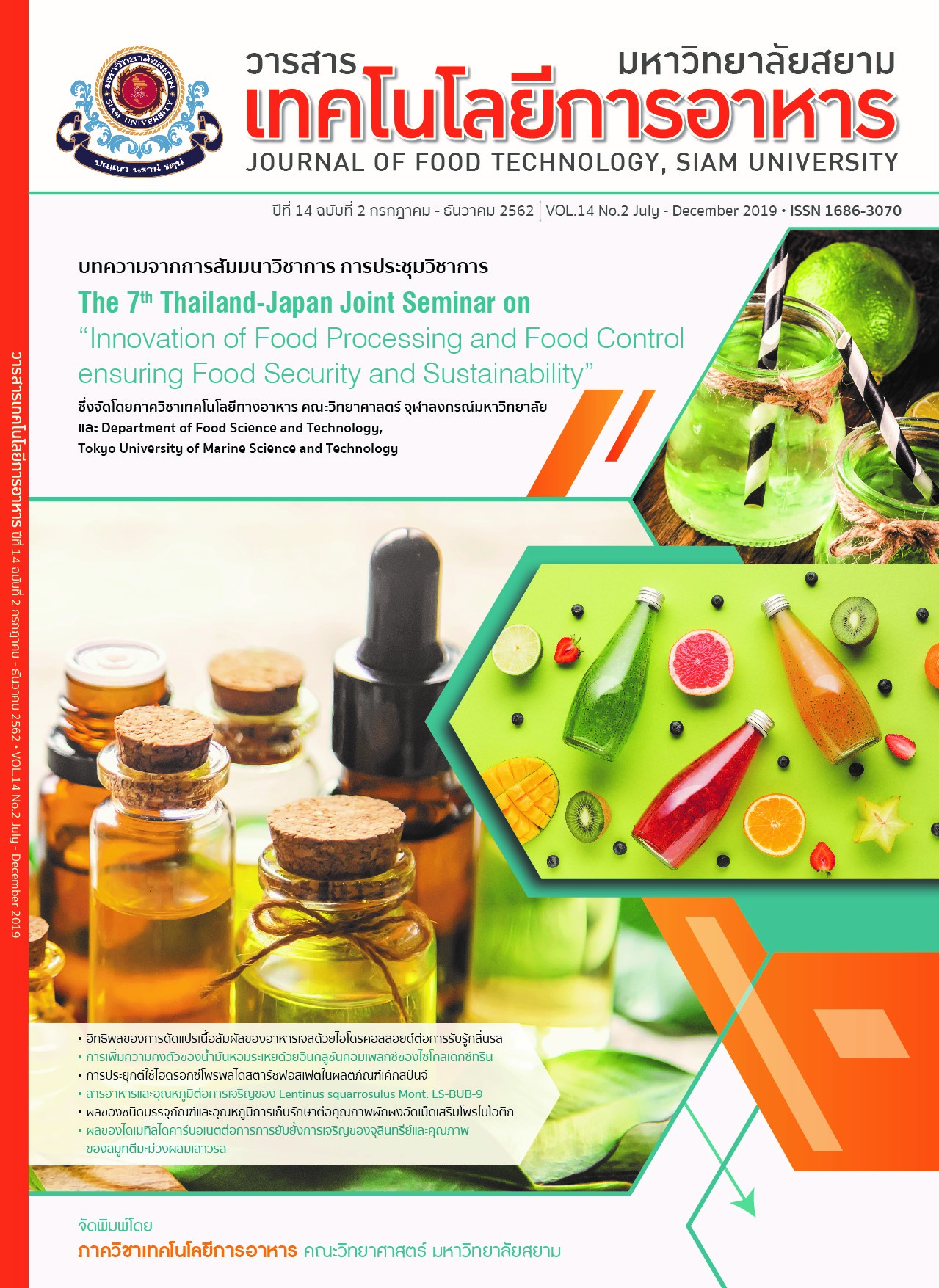Application of Hydroxypropyl Distarch Phosphate in Sponge Cake
Main Article Content
Abstract
Objective of this research was to study effects of wheat flour substituted by hydroxypropyl distarch phosphate (HDP) on physical properties and sensory characteristics of sponge cake. Results showed that 20-40% of wheat flour substituted by HDP resulted in a decreasing specific gravity of the cake batter, specific volume, standing height and volume index of the cakes, comparing to those of the control formula (p≤0.05). The cake with 40% HPD had the lowest hardness and gumminess (p≤0.05). Air cells distribution within the HDP-containing cake crumbs were non-uniform and the numbers of air cells were greater and larger. There was no significant difference in scores of color, texture, taste and overall acceptability of the cake samples with HDP (p>0.05), while the score of appearance was lower than that of the control (p≤0.05). Substitution with 30% HDP was the highest value providing a non-significant difference in hardness of cake with comparison of the control (p>0.05). Its score of appearance was in the range of ‘slightly to moderately preferred’. Therefore, this formula (30% HDP substitution) was selected for studying changes in cake quality during 7-day storage at 25°C. Hardness, gumminess, chewiness and aw of the exterior parts increased, while aw of the interior parts of the cakes greatly decreased (p≤0.05) within the first two days of storage. Those parameters changed slightly afterwards. Moreover, it was clearly shown that substitution of wheat flour with 30% HDP could retard an increase in hardness of the cake during the storage.
Article Details
Copyrights of all articles in the Journal of Food Technology available in print or online are owned by Siam University and protected by law.
References
[2] Yang, X. and Foegeding, E. A. (2010). Effects of sucrose on egg white protein and whey protein isolate foams: Factors determining properties of wet and dry foams (cakes). Food Hydrocolloids. 24(2): 227-238.
[3] Poonnakasem, N. (2014). Effect of hydrocolloids and lipids on physicochemical properties and consumer acceptance of sponge cake. Ph.D. Dissertation, Department of Food Technology, Faculty of Science, Chulalongkorn University.
[4] Chaiya, B. and Pongsawatmanit, R. (2011). Quality of batter and sponge cake prepared from wheat-tapioca flour blends. Kasetsart Journal of Natural Science. 45(2): 305-313.
[5] Singh, J., Kaur, L. and McCarthy, O. J. (2007). Factors influencing the physico-chemical, morphological, thermal and rheological properties of some chemically modified starches for food applications—A review. Food Hydrocolloids. 21: 1-22.
[6] Tulyathan, V. (2006). Food Chemistry of Carbohydrate. Bangkok: Chulalongkorn University Press. (in Thai)
[7] Kim, C.S. and Walker, C.E. (1992). Interactions between starches, sugars, and emulsifiers in high-ratio cake model systems. Cereal Chemistry. 69(2): 206-212.
[8] Lee, C.C., Hoseney, R.C. and Varriano-Marston, E. (1982). Development of a laboratory-scale single-stage cake mix. Cereal Chemistry. 59(2): 389 - 392.
[9] Baker, B.A., Davis, E.A. and Gordon, J. (1990). The influence of sugar and emulsifier type during microwave and conventional heating of a lean formula cake batter. Cereal Chemistry. 67(3): 451-457.
[10] Pong, L., Johnson, J.M., Barbeau, W.E. and Stewart, D.L. (1991). Evaluation of alternative fat and sweetener systems in cupcakes. Cereal Chemistry. 68(5): 552-555.
[11] Cloke, J.D., Davis, E.A. and Gordon, J. (1984). Volume measurements calculated by several methods using cross-sectional tracings of cake. Cereal Chemistry. 61(4): 375-377.
[12] Lee, C.C., Johnson, L.A., Love, J.A. and Johnson, S. (1991). Effects of processing and usage level on performance of bovine plasma as an egg white substitute in cakes. Cereal Chemistry. 68(1): 100-104.
[13] AOAC. (1995). Official Methods of Analysis. Washington D.C.: Association of Official Analytical Chemists.
[14] Wilderjans, E., Luyts, A., Brijs, K. and Delcour, J.A. (2013). Ingredient functionality in batter type cake making. Trends in Food Science & Technology. 30(1): 6-15.
[15] Wilderjans, E., Luyts, A., Goesaert, H., Brijs, K. and Delcour, J.A. (2010). A model approach to starch and protein functionality in a pound cake system. Food Chemistry. 120(1): 44-51.
[16] Luyts, A., Wilderjans, E., Van Haesendonck, I., Brijs, K., Courtin, C.M. and Delcour, J.A. (2013). Relative importance of moisture migration and amylopectin retrogradation for pound cake crumb firming. Food Chemistry. 141(4): 3960-3966.

